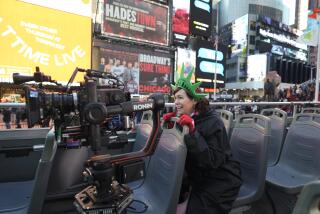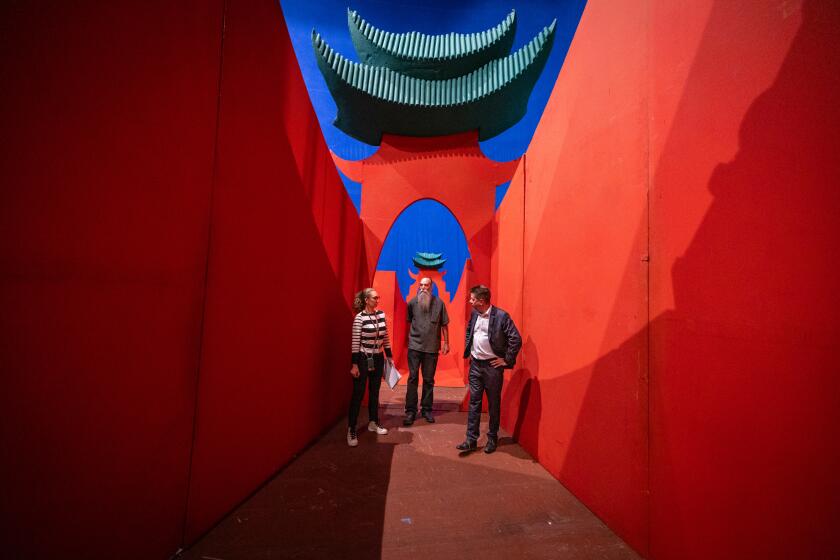O.C. ART / CATHY CURTIS : Out of the Ordinary : Tim Hawkinson Finds Incredible Potential in Everyday Objects
“Ohhh!” breathed the young woman who stepped into Chapman University’s Guggenheim Gallery the other day. “That’s cool !”
Her friends agreed. So do I.
Los Angeles artist Tim Hawkinson is on a roll, and it’s great to see his work in Orange County again. (Earlier pieces were included in “Imperfect Order,” an exhibition at the Irvine Fine Arts Center two years ago.)
Hawkinson finds incredible potential in such ordinary things as steak knives, extension cords, dog chews, strapping tape and burnt matches. This stuff becomes raw material for funky experiments that have their own internal logic.
Like? Well, like the side table Hawkinson flipped on its side and stuffed with a plastic Thermos jar studded with a pattern of screws. Hooked up to a motor, the jar revolves. The screws keep bumping into a row of serrated metal pieces (the business ends of the steak knives), and the result is a continuous series of magical pinging sounds.
The piece is called “Music Box (if I could save time in a bottle),” suggesting the sweet conceit of music as time made audible and stashed in a bottle, like miniature ships or secret messages. By employing a decidedly 20th-Century domestic version of a bottle--equipped with insulation to prolong the life of what’s inside--Hawkinson handily extends the metaphor.
Speaking of ships, Hawkinson’s “Das Tannenboot” is a dead Christmas tree stripped of its needles and re-envisioned as an unlikely source of spars for a multitude of tiny, meticulously crafted ship masts and riggings.
*
The title turns the German word for Christmas tree ( das Tannenbaum ) into the equivalent of “Christmas boat.” The sailing ship imagery and the metaphorical quality of a lifeless holiday remnant suggest the fate of the German U-boat crew in the movie “Das Boot” (they get a taste of Christmas festivities before becoming casualties of war).
Other notions spinning around the piece might include the medieval image of earthly existence as a “ship of fools” and (in view of the vintage quality of the imagery) the colonists’ bitter Christmas siege during the American Revolutionary War.
One of the most gratifying aspects of Hawkinson’s work is that it is immediately inviting on a purely physical level. Part of the enjoyment has to do with the way the pieces telegraph their tinkering spirit, their sense of “let’s put this with that and see what we’ve got.”
There are plenty of precedents for using everyday objects or castoff junk in art (a tactic first explored in the 1920s by Dada artists) as well as for making sculpture that moves (kinetic art had its heyday in the 1960s). But Hawkinson has a unique and specific approach that remains grounded in everyday actions even as it plays kiss-and-tell games with art history and language, and brokers outlandish marriages between form and function.
A lustrous object on the wall lures the eyeballs with a sensory whoosh: The large circular pattern of transparent, shiny material has a moire effect like a hologram. Pieced together with short lengths of strapping tape on flattened cardboard boxes, “Pearl Vision” suggests a double trance state: of the viewer blissed out by staring at the piece, and of the artist totally immersed in the soothing obsessiveness of tearing, placing and smoothing rolls of tape.
The most eye-catching piece in the show consists of three huge, air-filled latex protrusions, connected by silver foil-covered hoses, that huddle together on the wall and floor. There is something both placid and menacing about these pneumatic wonders, which Hawkinson calls “Rubber Balls and Liquor.” I’m not sure why he does so, except that the title suggests a slapstick accident waiting to happen, or an unfortunate cause-and-effect relationship between alcohol and sexual organs.
Like a bored prisoner or a manic inventor, Hawkinson’s mind seems so riveted on seemingly worthless or banal things that he uncovers potentials no one knew they had. What tricks can an extension cord do? Well, it can pretend to be a ball of yarn or a spider’s filament, thereby extending ordinary ordinary notions of usefulness, craft and ingenuity.
Connected to each other via a series of high-wires--suggesting the nimbleness of a circus act--an orange extension cord is “knitted” into a pair of orange shorts, and a “crocheted” blue doily hovers near the ceiling like an ersatz spider web.
*
In “Vessel,” a tour de force of substitution and “connection,” a cord imitating one craft (knitting) is pressed into service to imitate another (ceramics). Amusingly, the vessel has the sagging look of amateur ceramics, perhaps a metaphor for the makeshift effect inevitably accompanying the use of extension cords.
There’s more great stuff, notably “Penitent,” which looks like a cross between the Invisible Man and the skeletal images of memento mori art. It was assembled from bone-shaped dog chews, plastic tubing, a water bottle and a continuous whistling device that infuses the piece with a ghost-breath: at once eerie and cheery.
Poised like a philosophical riddle between life and death, the “Penitent” is a metaphor for the improvised state in which we live. As in all of Hawkinson’s best work, the metaphorical part seems almost a throwaway, a subliminal whisper from an object so weirdly familiar and yet so weirdly different that it practically exerts a gravitational pull.
* “Tim Hawkinson: Recent Works” remains through April 29 at the Guggenheim Gallery, Chapman University, 333 N. Gla s sell St. in Orange. Hours: Noon to 5 p.m., Monday through Friday; 11 a.m. to 4 p.m. Saturday. Admission: Free. (714) 997-6729.
More to Read
The biggest entertainment stories
Get our big stories about Hollywood, film, television, music, arts, culture and more right in your inbox as soon as they publish.
You may occasionally receive promotional content from the Los Angeles Times.






